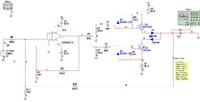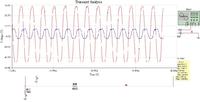Follow along with the video below to see how to install our site as a web app on your home screen.
Note: This feature may not be available in some browsers.
Congratulations!Hey, I did so here is layout now ... I added a high-speed operational amplifier ...
the input signal is 5 MHz sine wave 2 Vpp
Seems this has something to do with your C1*R3 time constant = 80µs. You could check this easily by changing R3 .problem is the slow growth of the signal up to 100 Vp




I just tried to throw R8 in order to reduce the enhancement .. but did not improve the simulation
Unlink R11 from GND and use it instead of R8, to achieve an overall gain of ≈10 !What else can I try to eliminate this overdrive?
That's what I - most likely - anticipated.I did like you saidwith the R8 ... but unfortunately, the amplifier is not stabilized
with your original (gain ≈ 100) circuit configuration?Another possibility is to reduce the signal output from the frequency generator by about an order of magnitude.

Do you mean Multisim? It basically knows about feedback.I came to conclusion, together with my professor ... that the program probably ignores feedback in circuit
The respective circuit libraries (*.lib) have to be imported in addition to the symbols (*.slb).I have a problem with the implementation of components such as transistors and operational amplifier ...
I have a library but in simulation is an error that the elements are undefined